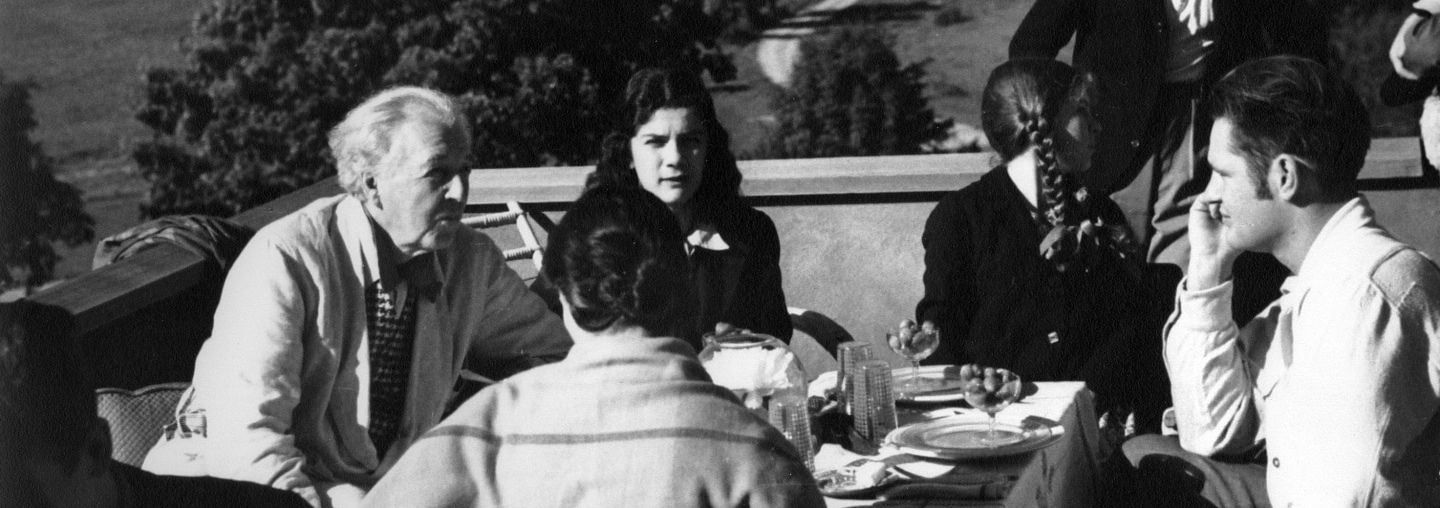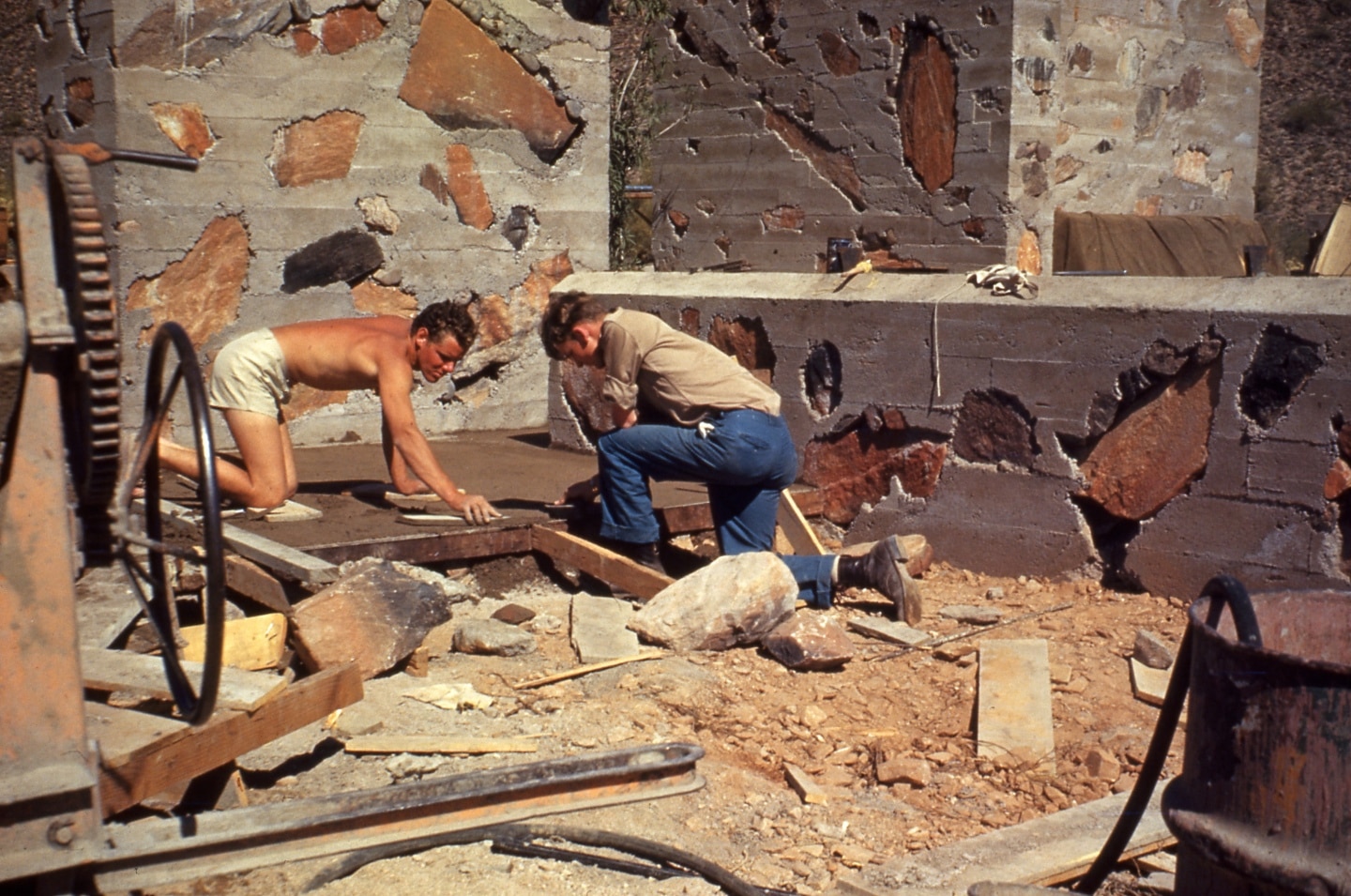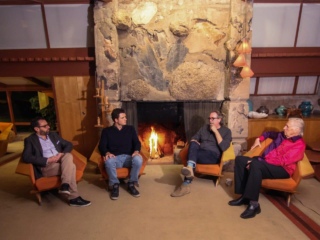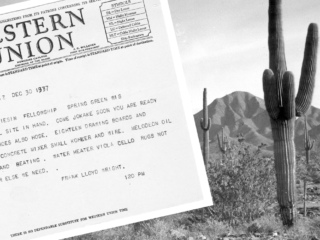
The Taliesin Fellowship
Frank Lloyd Wright Foundation | Jan 1, 2017
The goal of the Fellowship was “to develop a well correlated, creative human being with a wide horizon but capable of effective concentration of his faculties upon the circumstance in which he lives.”
In 1932, Frank Lloyd Wright and his wife, Olgivanna, created the Taliesin Fellowship, a community of apprentices and their families who lived, worked and studied with Wright first at Taliesin in Wisconsin and later also at Taliesin West in Arizona. The program provided a total learning environment integrating all aspects of the apprentices’ lives with the intent of educating responsible, creative and cultured human beings.
The idea for the Fellowship began to germinate at Taliesin, Wright’s home and studio near Spring Green, Wisconsin in 1928. Taliesin encompassed nearly 200 acres at the time and included his Hillside Home School building and surrounding acreage. The Hillside Home School had been founded by his aunts in 1887 as the first co-educational boarding school in Wisconsin and operated until 1915. The building was essentially abandoned over the ensuing years as Wright’s fortunes waxed and waned and was by the late 1920s in serious disrepair. It was during this challenging period that the Wrights conceived the idea that the building could be rehabilitated and that there they could establish an “industrial style center.” This center would serve as a school “allied with and supported by industry… to be equipped with modern machinery donated by industry and operated by competent machinists supplied by industry. Seven industrial arts were to be represented.

Apprentice John Rattenbury speaks to Olgivanna and Frank Lloyd Wright at a Venetian-themed party.
In his book, Working with Mr. Wright: What It Was Like, apprentice Curtis Besinger wrote of the Fellowship:
“This proposed School of the Allied Arts was not to be an art school but a ‘hive of industry.’ At its core, as inspiration, were to stand the Fine Arts, with Architecture as the leader. Grouped with and supplementing Architecture were to be divisions of Painting, Sculpture, Music, Drama, and Dance. Allied with this inspirational core were to be seven branches of the Industrial Arts.”
A long list of potential teachers and visiting lecturers was drawn up. Some of the best-known practitioners in their fields were listed, including the poet Carl Sandburg, writer Somerset Maugham, playwright Eugene O’Neill, painter Georgia O’Keeffe, critic Lewis Mumford, landscape designer Jens Jenson, cellist Pablo Casals, composer Igor Stravinsky, and film director Sergei Eisenstein.
This vision proved too grand, however, and a less ambitious program was formally proposed in 1932. That summer, the Wrights sent out a letter stating, “An Extension of the Work in Architecture at Taliesin to include Apprentices in Residence.” This more modest proposal found an enthusiastic response among a young audience, nearly 30 of whom became the “Charter Applicants,” among them William Wesley Peters and John H. Howe, both of whom would stay on for many years lending both talent and stability to the Fellowship Community. And so, the Taliesin Fellowship began operation with the understanding that except for any tuition that apprentices might pay, the activity would be largely self-supported and self-sustaining.

From the 1950s to the 1980s, under the direction of the Wrights’ daughter Iovanna (middle), a choreographer and dancer, Festivals of Music and Dance were created and publicly presented almost yearly, by Fellowship members.
The Taliesin Fellowship was from the beginning to be a community, everyone participating in and contributing to all the activities required of daily living. The basic philosophy was “learning by doing” and this was the foundation of everything. With little studio work, the primary tasks of the first year or so were get to the buildings ready for use as accommodations and work spaces. But in addition to this construction work. the apprentices also helped farm the land to produce fruits and vegetables and raise chickens, pigs and cows.
The goal of the Fellowship was “to develop a well correlated, creative human being with a wide horizon but capable of effective concentration of his faculties upon the circumstance in which he lives.” Wright noted that when they chose the word Fellowship they “meant fellowship in the finest sense of the term…to turn out a better [person] with a deeper mind and a more lively imagination by way of his association with us here.…There must be a faith and unity of feeling in order to get the expression here that we want to get. [The] Taliesin Fellowship….is composed of individuals, but…when you do come in you should give your whole thought, your whole self, your whole soul to it.”

Frank Lloyd Wright and the Fellowship have tea on Taliesin West’s Sunset Terrace.
An early apprentice, Yen Liang, summed it up this way:
“Aside from the revelations, which opened new vistas on architecture for me from close contact with the fertile mind of Mr. Wright, from living at Taliesin—rich in architectural ideas and heart-breakingly beautiful—from working in the drafting room, and from actual hands-on constructions in masonry, carpentry, plumbing, furniture building, and even lumber milling, I learned, without realizing it at the time, a way of life. His free and natural mingling among us imbued all daily activities with beauty, richness, and meaning.”
Every week a work list was drawn up assigning each Fellowship member specific tasks. Everyone rotated through kitchen detail, construction work, or drafting work in the studio. The Wrights believed that no work was too mundane or trivial to be taken seriously, and that every task should be done well, whether preparing dinner, arranging flowers, or emptying the garbage. This equal distribution of work created a very close-knit community, in spite of any difference in age or social or financial status.
Hard work was rewarded with parties and formal evenings, featuring music and drama and films each week. The Wrights also regularly gathered everyone together for a presentation or discussion on a wide range of subjects. And the Fellowship members were encouraged to develop their talents as musicians, potters, sculptors, dancers and cooks as well as architects. From the 1950s to the 1980s, under the direction of the Wrights’ daughter Iovanna, a choreographer and dancer, Festivals of Music and Dance were created and publicly presented almost yearly, by Fellowship members.
Many of the Fellowship members stayed for many years, and some remained their entire lives. Others came and went, taking away rich memories, their work built into the buildings and culture. There have been over a thousand apprentices over the years. After Wright’s death in 1959, Mrs. Wright supported and maintained the Fellowship and the architectural office, called Taliesin Associated Architects. Life went on much as before, except that more people were hired to do some of the jobs that the now busy architects, artists and home-grown administrators had done in the past.

Apprentices smooth concrete at Taliesin West in 1949.



